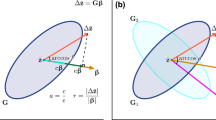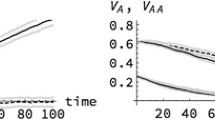Summary
The phenotypic values associated with the 3n genotypes obtained from all combinations of genes at n segregating loci, each with two alleles, can be completely described in terms of 3n parameters, 3n — 1 of which are attributed to the genetic effects of alleles at the n loci. The descriptions provide a system of linear equations, which can be solved for parameters specifying n additive, n dominance and 3n — 2n — 1 epistatic components of genetic effect. The solutions of the equations were obtained for two- and three-locus cases. The simple linear combination model was convenient for interpreting classical gene interactions in terms of biometrically definable parameters.
By the use of the unique solutions of the linear equations, the genetic parameters were directly estimated from the phenotypic values reported by three groups of workers for simplified genetic systems consisting of two or three loci. In most cases nonallelic gene interactions accounted for a major part of the total genetic effect. Conventional biometrical methods of partitioning genotypic sums of squares into various components were found to be inadequate for evaluating the role of epistasis in these simplified genetic systems.
Zusammenfassung
Die phänotypischen Werte der 3n Genotypen, die aus allen Kombinationen der Gene an n spaltenden Loci mit je 2 Allelen resultieren, können mit Hilfe von 3n Parametern vollständig beschrieben werden. Hiervon gehen 3n—1 Parameter auf genetische Effekte der Allele an den n Loci zurück. Die Beschreibungen setzen ein System linearer Gleichungen voraus, die hinsichtlich der Parameter, die n additive, n Dominanz- und 3n—2 n—1 epistatische Komponenten genetischer Effekte spezifizieren, gelöst werden können. Die Lösungen werden für 2- und 3-Locus-Fälle gegeben. Das einfache Modell linearer Kombination eignet sich zur Interpretation klassischer Geninteraktionen mit Hilfe biometrisch definierbarer Parameter.
Die genetischen Parameter wurden anhand der einzigen Lösungen der linearen Gleichungen direkt aus den phänotypischen Werten geschätzt, die für vereinfachte genetische Systeme mit 2 oder 3 Loci von 3 Forschergruppen berichtet wurden. In den meisten Fällen waren nichtallele Geninteraktionen für den größten Teil des gesamten genetischen Effekts verantwortlich. Konventionelle biometrische Methoden zur Aufteilung der genotypischen Varianzen in verschiedene Komponenten erwiesen sich als unzureichend, das Ausmaß der Epistasie in diesen einfachen genetischen Systemen richtig zu bewerten.
Similar content being viewed by others
References
Cockerham, C. C.: An extension of the concept of partioning hereditary variance for analysis of covariance among relatives when epistasis is present. Genetics 39, 859–882 (1954).
Crow, J. F., Kimura, M.: An introduction to population genetics theory. New York, N.Y.: Harper and Row 1970.
East, E. M.: Inheritance in crosses between Nicotiana langsdorfi and Nicotiana alata. Genetics 1, 311–333 (1916).
Fasoulas, A. C., Allard, R. W.: Nonallelic gene interactions in the inheritance of quantitative characters in barley. Genetics 47, 899–907 (1962).
Jana, S., Seyffert, W.: Simulation of quantitative characters by genes with biochemically definable action. III. The components of genetic effects in the inheritance of anthocyanins in Matthiola incana R. Br. Submitted to TAG.
Law, C. N.: The location of genetic factors controlling a number of quantitative characters in wheat. Genetics 56, 445–461 (1967).
Lee, J. A., Cockerham, C. C., Smith, E. H.: The inheritance of gossypol level in Gossypium. I. Additive, dominance, epistatic, and maternal effects associated with seed gossypol in two varieties of Gossypum hirsutum L. Genetics 59, 288–298 (1968).
Mather, K.: Complementary and duplicate gene interactions in biometrical genetics. Heredity 22, 97–103 (1967).
Russel, W. A., Eberhart, S. A.: Effects of three gene loci in the inheritance of quantitative characters in maize. Crop Sci. 10, 165–169 (1970).
Seyffert, W.: Die Simulation quantitativer Merkmale durch Gene mit biochemisch definierbarer Wirkung. I. Ein einfaches Modell. Züchter 36, 159–163 (1966).
Simchen, G., Jinks, J. L.: The determination of dikaryotic growth rate in the basidiomycete Schizophyllum commune: A biometrical analysis. Heredity 19, 629–649 (1964).
Spickett, S. G., Thoday, J. M.: Regular responses to selection. 3. Interaction between located polygenes. Genet. Res. 1, 96–121 (1966).
Stewart, J.: Biometrical genetics with one or two loci. I. The choice of specific genetic model. Heredity 24, 211–224 (1969).
Wehrhahn, C., Allard, R. W.: The detection and measurement of the effects of individual genes involved in the inheritance of a quantitative character in wheat. Genetics 51, 109–119 (1965).
Author information
Authors and Affiliations
Additional information
Communicated by W. Seyffert
The investigation was supported by a grant from the National Research Council of Canada (Grant No. A 6221).
Rights and permissions
About this article
Cite this article
Jana, S. Simulation of quantitative characters from qualitatively acting genes. Theoret. Appl. Genetics 41, 216–226 (1971). https://doi.org/10.1007/BF00279773
Received:
Issue Date:
DOI: https://doi.org/10.1007/BF00279773




